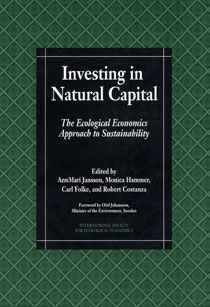About ISEE
Foreword
Preface
Chapter 1. Investing in Natural Capital—Why, What, And How?
-Abstract
-What Is Ecological Economics and Why Do We Need It to Achieve Sustainability?
-Research Issues for Ecological Economics
-Policy Recommendations
-Acknowledgments
-References
PART I. Perspectives on Maintaining and Investing in Natural Capital
Chapter 2. Operationalizing Sustainable Development by Investing in Natural Capital
Chapter 3. Ecological Economics and the Carrying Capacity of Earth
Chapter 4. New Science and New Investments for a Sustainable Biosphere
Chapter 5. Ecosystem Properties as a Basis for Sustainability
Chapter 6. Biotic Diversity, Sustainable Development, and Natural Capital
Chapter 7. Sustenance and Sustainability: How Can We Preserve and Consume without Major Conflict?
Chapter 8. Investing in Cultural Capital for Sustainable Use of Natural Capital
PART II. Ecological Economic Methods and Case-studies on the Significance of Natural Capital
Chapter 9. Environmental Functions and the Economic Value of Natural Ecosystems
Chapter 10. Rebuilding a Humane and Ethical Decision System for Investing in Natural Capital
Chapter 11. Re-allocating Work between Human and Natural Capital in Agriculture: Examples from India and the United States
Chapter 12. The Emergy of Natural Capital
Chapter 13. Modeling of Ecological and Economic Systems at the Watershed Scale for Sustainable Development
Chapter 14. Multiple Use of Environmental Resources: A Household Production Function Approach to Valuing Natural Capital
Chapter 15. Strategies for Environmentally Sound Economic Development
Chapter 16. Sea-level Rise and Coastal Wetlands in the U.K.: Mitigation Strategies for Sustainable Management
Chapter 17. Natural Capital and the Economics of Environment and Development
Chapter 18. Can We Justify Sustainability? New Challenges Facing Ecological Economics
Chapter 19. Renewable Resources as Natural Capital: The Fishery
Chapter 20. Ecological Footprints and Appropriated Carrying Capacity: Measuring the Natural Capital Requirements of the Human Economy
PART III. Environmental Management and Policy Implications: Adjusting Economic, Technical, Socio-Political, and Cultural Systems
Chapter 21. Three General Policies to Achieve Sustainability
Chapter 22. Implementing Environmental Policies in Central and Eastern Europe
Chapter 23. Energy Production, Consumption, Environment, and Sustainability
Chapter 24. Economic Conversion, Engineers, and Sustainability
Chapter 25. Public Policy: Challenge to Ecological Economics
Chapter 26. Investing in Natural and Human Capital in Developing Countries
Index

